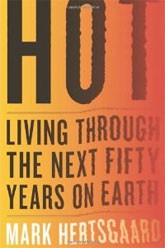Editor’s note: This post, by Sightline blogger Anna Fahey originally appeared in YES! Magazine.
“Everyone who finally ‘gets it’ about climate change has an ‘Oh, shit’ moment,” Mark Hertsgaard observes in Hot: Living Through the Next Fifty Years on Earth, “an instant when the pieces fall into place, the full implications of the science at last become clear, and you are left staring in horror at the monstrous situation humanity has created for itself.” I’ve had countless such moments. And for a climate policy nerd like me, Hertsgaard’s basic storyline is familiar—the climate impacts and the hopeful solutions. Arrogantly perhaps, I thought my eyes were as wide open as they could get. But two aspects of this book made it surprisingly cathartic for me.
First, Hertsgaard is writing as a father. As visions of the next 50 years come into focus and predicted events unfold, we’re reminded how old his little girl will be. Rising sea levels, drought, flooding, mass migrations, deadly heat waves, vulnerable food and water supplies—she’s 15, 30, 45. I hadn’t expected a wake-up call, but mapping impacts to my own one-year-old’s lifetime in the book’s margins, I allowed myself to acknowledge for the first time that climate change will define her life.
The second eye-opener is Hertsgaard’s focus on adaptation, a topic long forbidden in environmental circles as a signal of surrender. But coping efforts must now move forward as rapidly as mitigation to “manage the unavoidable and avoid the unmanageable,” as Hertsgaard puts it. Particularly intriguing to me is the idea that tackling adaptation may prove to be a badly needed stepping stone—an engagement strategy—for those dragging their feet on mitigation.
There are lots of reasons mitigation efforts have stalled (the power of fossil fuel lobbies and the multimillion-dollar campaign aimed at discrediting the science of global warming come to mind). But we may also be hard-wired for foot-dragging. The human brain has trouble visualizing a future different from the past; fear shuts us down rather than stirring us to action; and we’re good at filtering information that conflicts with our worldview. Rather than changing our minds, piling on more scientific evidence actually risks further entrenching preconceived notions.
Adaptation charts a middle path. It takes a problem of atmospheric proportions and makes it local—and far more concrete. Focusing on the imperative to protect ourselves and our assets makes it easier to come to terms with the problem. Hertsgaard illustrates this with examples of governments—from cities on up—building infrastructure and developing policy designed for the reality of climate change.
Although it sometimes borders on cliché, Hertsgaard’s fatherly lens nonetheless gave me license to grapple with the emotional dimensions of global warming, fears that I’d kept well compartmentalized. Would someone outside sustainability policy circles feel the same way, I wondered? As I read, I ticked off the names of friends who should read this book—friends who know there’s a problem and who’d do anything to protect their kids, but for whom the appropriate response remains a mystery.
Climate change has arrived a century earlier than predicted. We can’t avoid it. Still, anger and despair, while appropriate, aren’t going to get us far. Taking action to avoid the worst, Hertsgaard argues, has now become “part of a parent’s job description, no less vital than tending to your child’s diet, health, or education.” But how? That’s the question that stops even the most informed and motivated among us.
Most of the book is devoted to successful actions being taken around the world to prepare for climate disruption (as well as some of the biggest failures to do so) and some time is spent outlining policy-level solutions and the opportunities they represent (a “Green Apollo Program,” a price on carbon in the form of a cap-and-dividend policy, energy efficiency incentives, and investments in clean-energy technology). But only the final chapter touches on what an individual might actually start doing tomorrow, say. Get involved. Join the movement. Stand up against industry’s control over energy policy. Push for clean energy sources. Demand accountability from our lawmakers. Easier said than done, but easier to do than many might think. And time’s a-wasting.
One thing to do right now is to go online and check out Hertsgaard’s campaign to “throw the bums out” by naming and shaming elected officials he dubs climate cranks. It’s time to turn up the heat on policy makers at every level of government. Tell them your kids sent you!
Anna Fahey reviewed this book for Beyond Prisons, the Summer 2011 issue of YES! Magazine.


Comments are closed.